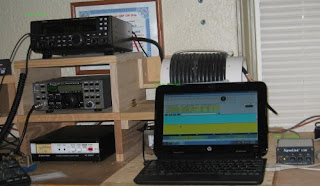


Well, it seems like MFJ is not currently making the Hy-Gain antenna I was looking at so I went ahead and bought a used Hustler 4BTV vertical with the DX Engineering 17 meter add-on. And the next thing I did was to buy some 14g copper wire--two 500 foot rolls. I have put down about 30 radials each at 34 ft. and will be putting down about a half-dozen more. The radials are directly on the ground and are pinned down with three-inch staples. This is to prevent any accidental uprooting of the wires when I am mowing the yard. I have tested this antenna and it is playing well! The pictures show the antenna, the radial plate I fashioned for the radials and the DX Engineering 17 meter trap. The antenna is a small package and stands at about 19 feet. I am hoping it will out-perform my inverted V which is only up about 30 feet. I am betting that it will work some serious DX, especially on 10, 15, and the 20 meter bands. It also plays well on 40 and I will be testing it on 17 meters in the near future.






